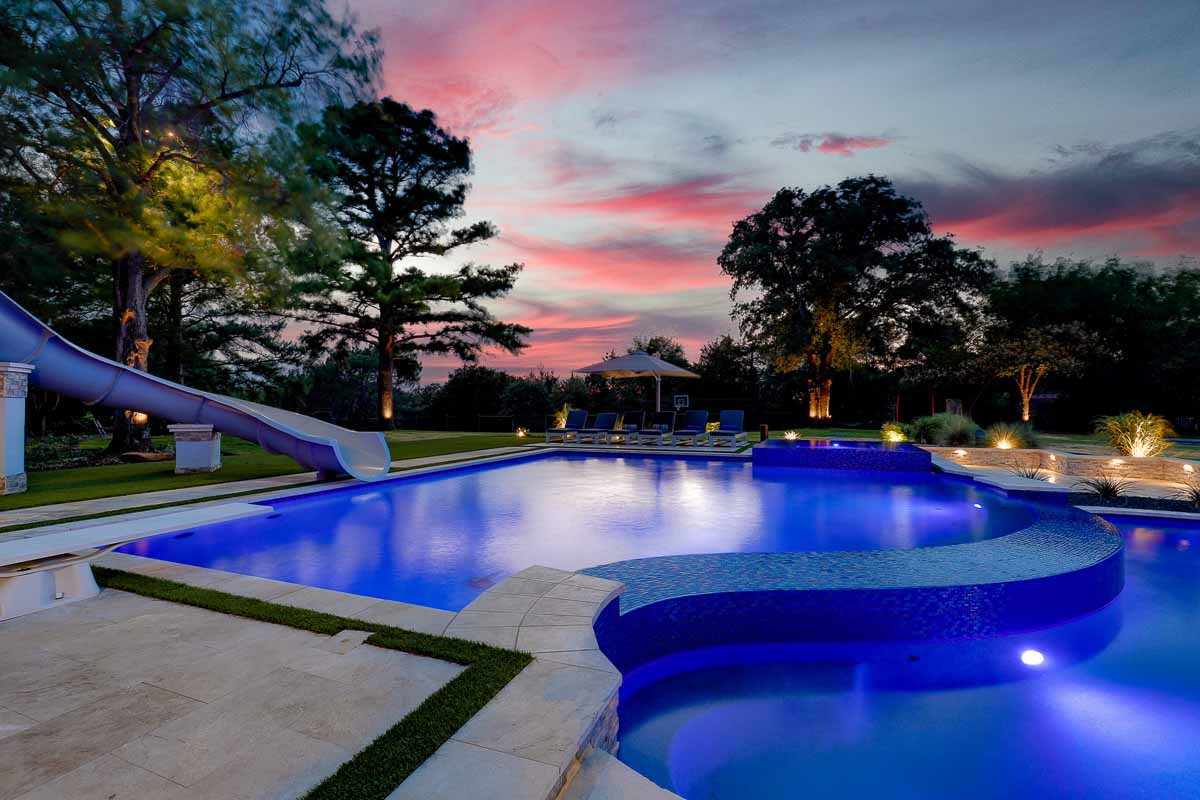
23 Aug Maximizing Your Backyard Space with a Custom Inground Pool
Creating a custom inground pool is a fantastic way to enhance your backyard and maximize your outdoor space. By thoughtfully designing and integrating your pool into your backyard, you can achieve a functional and aesthetically pleasing environment that complements your lifestyle. Here’s how to maximize your backyard space with a custom inground pool:
1. Assess and Plan Your Space
1.1. Evaluate Your Backyard:
Measure and Map: Take accurate backyard measurements to understand the available space. Consider factors like existing structures, landscaping, and utility lines.
Identify Constraints: Note any obstacles, such as slopes, trees, or proximity to the house, that could impact the pool’s design and placement.
1.2. Define Your Needs:
Usage Goals: Determine how you plan to use the pool. Your needs will guide the design, whether for relaxation, exercise, or entertainment.
Lifestyle Considerations: Consider any additional features you want, such as a spa, outdoor kitchen, or lounging areas.
1.3. Consult a Professional:
Design Expertise: Work with a professional pool designer or contractor to create a plan that maximizes your space and integrates seamlessly with your backyard.
2. Design for Functionality
2.1. Optimize Pool Shape and Size:
Custom Shapes: Choose a pool shape that fits your space and complements the layout of your backyard. Options include rectangular, freeform, or geometric designs.
Size Considerations: Ensure the pool size is proportionate to your backyard and accommodates your intended use. A well-sized pool enhances usability without overwhelming the space.
2.2. Integrate Zones and Features:
Defined Areas: Create distinct zones around the pool for different activities, such as a dining area, lounge space, or fire pit.
Feature Integration: Incorporate features like a sun shelf, waterfall, or built-in seating to enhance the pool’s functionality and visual appeal.
3. Enhance Aesthetics with Landscaping
3.1. Complementary Landscaping:
Plant Selection: Choose plants that complement the pool and enhance the overall look of your backyard. Consider using low-maintenance and drought-resistant plants.
Softscaping: Add garden beds, grass areas, or flower beds to create a natural and inviting environment around the pool.
3.2. Hardscaping Elements:
Decking and Patios: Select decking materials that match your pool design and provide a cohesive look. Options include concrete, pavers, wood, or composite materials.
Walkways and Paths: Design walkways or paths to ensure easy access around the pool and other areas of your backyard.
3.3. Privacy and Shade:
Screening: Use privacy screens, fences, or tall plants to create a secluded area around the pool. This adds to the comfort and enjoyment of the space.
Shade Solutions: Incorporate shade structures like pergolas, umbrellas, or retractable awnings to provide relief from the sun and extend the usability of your outdoor space.
4. Incorporate Functional Outdoor Living Areas
4.1. Outdoor Kitchen and Dining:
Cooking and Entertaining: Design an outdoor kitchen or dining area adjacent to the pool. Include a grill, refrigerator, and dining table to create a complete outdoor experience.
Seating Options: Provide ample seating options around the pool and dining areas to accommodate guests and family.
4.2. Relaxation Zones:
Lounge Areas: Add comfortable lounge chairs or built-in seating around the pool for relaxation. You should consider incorporating cushioned furniture or hammocks for added comfort.
Fire Features: Include a fire pit or outdoor fireplace to create a cozy ambiance and extend the enjoyment of the pool area into the evening.
4.3. Entertainment Options:
Audio and Visual: To enhance entertainment options, install outdoor speakers and a weather-resistant TV. Choose equipment designed for outdoor use to withstand the elements.
Games and Activities: Consider adding features like a table tennis area, cornhole, or a pool table to provide additional recreational options.
5. Consider Practical Aspects
5.1. Safety Measures:
Fencing and Covers: Install safety fences, covers, or alarms to ensure the pool area is safe for children and pets.
Non-Slip Surfaces: To prevent accidents, choose non-slip materials for pool decking and surrounding areas.
5.2. Maintenance and Accessibility:
Ease of Access: Design the pool area for easy maintenance and accessibility. Include features like steps, handrails, and storage for pool equipment.
Maintenance Solutions: To simplify upkeep, consider options for automated pool cleaning systems, such as robotic cleaners or built-in skimmers.
5.3. Lighting:
Ambiance and Safety: Use a combination of ambient, task, and accent lighting to enhance the pool area’s aesthetics and ensure safety during evening use.
Energy Efficiency: Opt for energy-efficient LED lighting to reduce electricity costs and minimize environmental impact.
Conclusion
Maximizing your backyard with a custom inground pool involves thoughtful design and planning to create a functional, beautiful, and enjoyable outdoor area. By assessing your space, optimizing the pool’s shape and size, enhancing aesthetics with landscaping, incorporating functional living areas, and considering practical aspects, you can transform your backyard into a personalized oasis that meets your needs and reflects your style. Whether you are looking for a relaxing retreat or a vibrant entertainment space, a custom inground pool can center your outdoor living experience.


